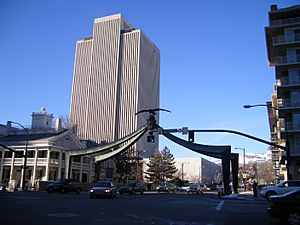Beehive House facts for kids
Quick facts for kids |
|
|
Beehive House
|
|
|
U.S. National Historic Landmark District
Contributing Property |
|

South Temple Street entrance to the Beehive House
|
|
| Location | 67 E South Temple St, Salt Lake City, Utah |
|---|---|
| Built | 1854 |
| Architect | Angell, Truman O. |
| Architectural style | Greek Revival |
| Part of | Brigham Young Complex (ID66000739) |
| NRHP reference No. | 70000626 |
| Added to NRHP | February 26, 1970 |

The Beehive House was a special home for Brigham Young. He was the second President of the Church of Jesus Christ of Latter-day Saints. This historic house is in Salt Lake City, Utah, United States. It got its name from a cool beehive sculpture on top of the building.
Today, the Beehive House is usually a historic house museum. Visitors can learn about its past. However, it has been closed for updates since 2023. It is expected to open again in 2025.
Contents
Brigham Young's Important Home
The Beehive House was built in 1854. This was two years before the Lion House, another home of Young's, was built next door. Both houses are very close to the Salt Lake Temple and Temple Square. They are located on South Temple street in downtown Salt Lake City.
Young's brother-in-law, Truman O. Angell, designed the home. He was also the architect for the Salt Lake Temple. The house was made from adobe (a type of mud brick) and sandstone.
Brigham Young had a very large family. The Beehive House was designed to fit everyone comfortably. It also became his official home as the governor of Utah Territory. Plus, it was his official residence as the president of the Church.
When the house was finished, Young lived there with his family. Lucy Ann Decker Young, one of his family members, became the hostess of the Beehive House. She lived there with her nine children.
The Beehive House served as the main official residence for Utah Territory from 1852 to 1855. Brigham Young often welcomed important guests there. The home is connected to the Lion House by a set of rooms. These rooms included Young's offices and his private bedroom. He passed away in that bedroom in 1877.
What Happened After Young's Death
After Brigham Young passed away, there was a lot of discussion about his property. People wondered what belonged to his family and what belonged to the Church. The Beehive House was one of the properties discussed. In the end, it was given to Young's family.
The Beehive House was later replaced as the official residence by the Gardo House. For a short time, two Church presidents, John Taylor and Wilford Woodruff, lived in the Beehive House.
In the late 1880s, Young's son, John W. Young, added a large Victorian-style section to the back of the house. He also updated the older parts of the home. However, the Young family lost the house in 1893. It was sold to pay off debts that John W. Young had.
John Beck, a successful miner, lived in the home briefly. Then it was sold again to pay his debts. Eventually, the Church bought the house. It became the official home for Church presidents Lorenzo Snow and Joseph F. Smith. Both of them passed away while living in the mansion. Joseph F. Smith, who passed away in 1918, lived in the house with members of his family.
Later History of the House
A Home for Young Women
In 1920, a group called the Young Women Mutual Improvement Association opened the Beehive House. It became a boarding home for single women. Many of these women worked as secretaries at the Church's headquarters nearby. The Beehive House continued to be a boarding home until the 1950s.
Bringing the House Back to Life
The building was carefully restored between 1959 and 1960. This work was led by Georgius Y. Cannon, who was Brigham Young's grandson. Now, it is a historic house museum. It has furniture and items from the time Brigham Young lived there. Many of these items are original to the house. They help show what life was like for the Young family in the mid-1800s. Church missionaries offer free daily tours.
Temporary Closing for Visitors
In 2020, the Beehive House and other historic places on Temple Square closed to the public. This was due to the COVID-19 pandemic in the United States. As mentioned earlier, it is currently closed for renovations and is expected to reopen in 2025.
See also
- Brigham Young Forest Farmhouse
- Brigham Young Historic Park
- Brigham Young Winter Home and Office

